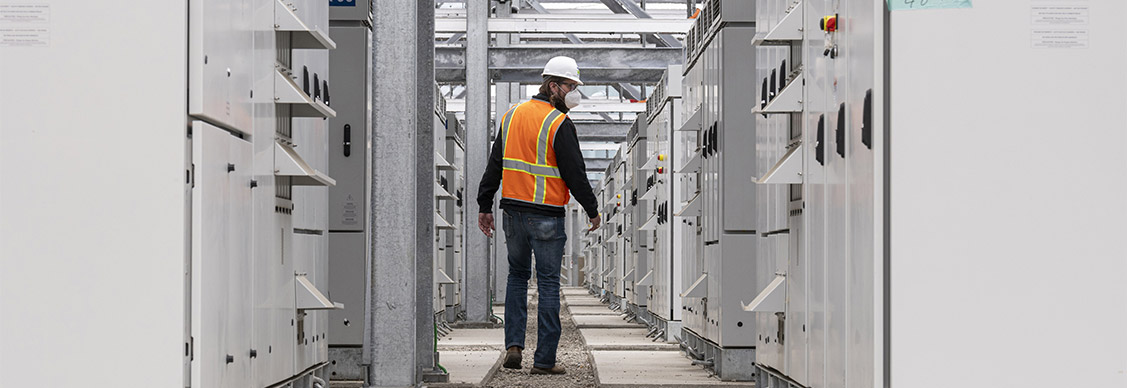Why battery storage is a new growth area for investors
Interest is rising in the energy sub-sector amid a growing focus on renewable power
As more buildings and urban infrastructure turn to renewable energy sources for their power needs, investment in battery storage systems is starting to follow suit.
With solar and wind generation helping renewable energy to last year eclipse fossil fuels in Europe, the demand for energy storage is rising to ensure reliable round-the-clock power supplies.
“As we move into renewable energy supply, its provision is less consistent than fossil fuel due to variations in sun and wind,” Richard Batten, JLL’s Global Chief Sustainability Officer, tells Bloomberg Green. “The challenge is to increase the number of hours that renewables can interact with the built environment. Hence the need to create storage mechanisms to cover the lack of consistency of delivery. Batteries are crucial to enable this.”
Globally, the grid battery energy storage market is tipped to grow by 23 percent by 2030, according to research firm Frost & Sullivan.
Rising demand for storage is expected to increase annual market revenue from US$2 billion last year to around US$16 billion by 2030. In the UK, where battery storage totals around 1.2GW today, it’s expected to double in the next 24 months, says Peter Sermon, Energy and Infrastructure Advisory director at JLL.
“The value associated with addressing the imbalance between electricity supply and demand caused by variable solar and wind generation has caught the eye of developers, owner-operators and traders,” he explains. “But we’re only really at the beginning. Many new projects are emerging – and many more will be needed to satisfy grid demand.”
Battery storage gets bigger
Late last year, the UK’s largest battery went live, helping National Grid ESO as it aims to balance its grid. The 75MWh energy storage system battery was backed by Gresham House’s Energy Storage Fund and flexible energy specialist Flexitricity. France’s biggest battery storage system is now connected, while a consortium of public and private partners is funding a battery energy storage system in Belgium’s southern Wallonia region.
These long-term projects are addressing sustainability criteria that many investors are now factoring in. “As more renewable energy sources are built out over the next decade, batteries will become an increasingly attractive source of revenue, and a hedge for renewable investors against solar and wind revenues that are threatened by self-cannibalisation of power prices, as more and more capacity is build out,” says Sermon.
Looking for more insights? Never miss an update.
The latest news, insights and opportunities from global commercial real estate markets straight to your inbox.
Regulation changes
Such is the momentum, that regulation had fallen behind the market as lawmakers in the European Union begin to lift barriers for energy storage.
EU member states were given until the start of 2021 to write the revised electricity directive, which aims to increase competition and ensure fair access to storage facilities for all market participants, into law.
“We’ve seen countries’ respective regulatory systems playing catch up,” says Sermon. “But now regulatory frameworks are taking shape, opportunities are emerging.”
Since the start of 2021, Italy’s electricity grid manager, Terna has awarded five-year contracts to battery storage developers including global energy developer/investor METKA EGN and Italy’s Enel X, as well as China’s Trina Solar and Italian energy firm company Eni. These are expected to be online by 2023.
Investment Opportunities
Italy's National Energy and Climate Plan, which brings the country in line with EU climate and clean energy targets for 2030, calls for around 40GW of renewable energy capacity. That has led to predictions that the country will need at least 5GW of new energy storage.
In February, Spain’s government approved its energy storage strategy, targeting some 20GW of storage capacity in 2030, up from today’s 8.3GW, while in May, Spanish utility group Iberdrola completed the country’s first battery storage system on a solar farm.
Funding is also available, with up to €10 billion of grants available from the EU Innovation Fund until 2030 and the European Investment Bank lending €1 billion to battery projects last year.
“With the majority of investment opportunities lying in pre-construction rather than operational, the sector has strong growth in front of it,” Sermon says. “Policy and regulatory support, alongside the ongoing renewable energy transition, will drive the battery storage sector forward - and should give rise to greater interaction between energy firms, developers and investors.”
Contact Peter Sermon
Director, Energy & Infrastructure AdvisoryWhat’s your investment ambition?
Uncover opportunities and capital sources all over the world and discover how we can help you achieve your investment goals.




